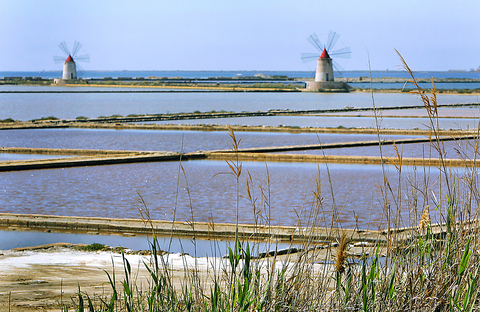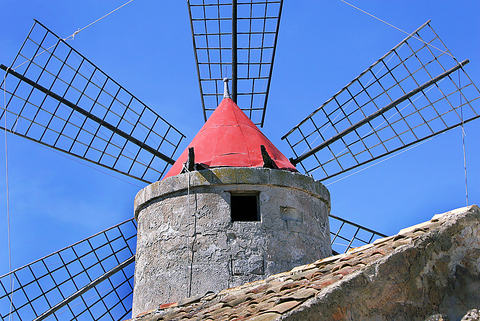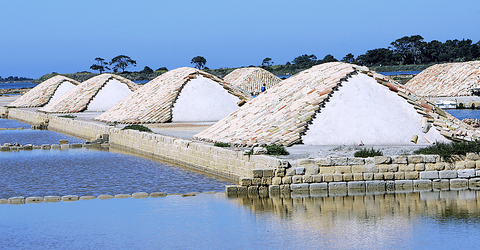Thousands of years ago, before Sicily became famous as the birthplace of the Mafia; before it retired the prize for the world's perfect oranges; before it was conquered by the Italians, or the Saracens, or even ancient Rome, this sprawling Mediterranean island was fiercely prized for its rich annual haul of salt.
When no one could imagine such a thing as a refrigerator, salt was by far the best way to preserve food. It was shipped across the sea, used as money, mixed into paste, and sculpted into jewelry.
Sicilians along the island's smooth western shore, blessed with saline water and hot windy summers, found themselves sitting on an almost priceless resource. They refined the technique of raking salt out of evaporated seawater, transforming the coast into a vast salt factory dotted with ponds, sluices, and nearly priceless white mounds.

PHOTOS: NY TIMES NEWS SERVICE
Two thousand years later, salt costs a US dollar a can in every supermarket in the world, and Sicily's biggest export for the past half-century has been its people. Modernity has created deep contradictions here: Tourists flock to extraordinary Greek ruins and the terraced four-star hotels of the east coast. There's a ski resort on volcanic, 3,352m Mount Etna. Behind that facade, the island remains a network of farms and poor villages struggling to lift itself from its corrupt feudal past.
But I had also heard that on the remote west coast there were still wide, shallow pools of seawater, and still a handful of people who spent Sicily's excruciating summer months raking evaporated slush into mounds of white crystals. It sounded so pointless, so labor-intensive, so Italian. Of course, I had to see it.
We were going to Sicily in any event. My wife studies ancient art, and we had mapped out a two-week trip around the island to see the remnants of Greek and Roman rule. The salt would require a modest little detour to the coastal city of Trapani, the unofficial capital of the salt industry.

It was March, well before the tourist season. To the east, resort hotels were just starting to unfurl their awnings. In the mountainous heart of the island, stiff winds were kicking up squalls of snow. Airport posters always make Sicily look like the Costa Brava, a playland of golden vineyards and beach umbrellas, but not this time of year. I stuffed my bathing suit into the bottom of my suitcase and bought a pair of thick felt pants.
We rented a white Fiat with a trunk that barely closed over our bags and headed west, away from the capital Palermo and the big resorts. I had been warned about the terrors of driving in Sicily, but we floated almost calmly across its broad ribbon highways, cutting through green hills speckled with the island's ubiquitous half-built concrete apartments. We laughed about our car's tiny engine and its tiny name — Punto, the Dot — until we started noticing other Fiat Puntos passing us at 193km an hour, straight into oncoming traffic. Far sooner than we expected, maybe an hour from the airport, we found ourselves approaching the salt coast.
The remnants of the salt industry may not be among the great tourist pilgrimages of the Mediterranean, but we didn't have much trouble tracking them down. Road signs marked out the Via del Sale, or Salt Road, which runs south from Trapani to the next coastal city, Marsala.

We followed it out of town and the road opened up to a series of flat coastal farms. As we approached the shore, the farms gave way to something strange: huge rectangular fields of water. The interconnected shallow pools line the coast for kilometers, sprinkled with windmills only recently supplanted by newer ways to pump water and grind salt crystals.
Our destination was the obvious one: the Museo delle Saline. The museum doesn't have an address, so we followed signs through a townlet called Nubia and hoped. At the edge of an aquatic nature reserve, under a flat sunny haze and a stiff wind, we turned into a parking lot with a single low stone building.
The museum has a restaurant for seasonal visitors and a gift shop, but when we got there the restaurant was closed. In fact, the entire parking lot stood empty except for one car that was stationed, strangely, right across the front entrance. As we approached, the car door opened and a woman got out. "Museo?" we asked her. She was the curator. We were the only visitors.
The salt museum isn't big, but like many specialized museums it conveys a kind of dusty intensity about its subject. I had assumed salt would be a pretty idiot-proof crop: You let a bunch of seawater evaporate in the sun, and when it's crunchy and white, you're done. Not quite. If it evaporates too fast or too slowly, other substances — bad substances — crystallize out of the seawater and you end up with bitter salt, or metallic salt, and some Phoenician or Aragonese prince tortures you until you get it right. Saltmaking turns out to be an art: The seawater flows into a giant lagoon, and then is pumped into a hierarchy of evaporating pools, each with its own depth, temperature, and name.
The museum's walls were covered with complex diagrams and tables of salinity, as if to say: We know you thought this was easy. Massive wooden wheels and Archimedes' screws evoked decades of backbreaking labor. The salt flats had a human hierarchy, too, in which the water was carefully tasted and monitored by a curatolo, whose father had taught him how to tell when the salt was ready. Everything in the museum — the walls, the charts, the equipment — seemed covered with a fine white dust. I rubbed my finger on the dust and licked it. Salty.
Sicilian salt has a reputation for tasting like minerals and being quick-dissolving; its proponents cite its high magnesium content as a culinary virtue. I could never tell the difference. For me, the crunch and spark of salt in Sicily was like drinking a glass of wine in a vineyard: Somehow the stuff just tastes better if you're standing on the slice of earth that produced it.
As it turned out, we were there at the wrong time to see any saltmaking. Harvest season wouldn't begin until midsummer, when wet salt floats to the surface of the last pools like a crown of heavy spring snow. Seasonal workers rake the slush off, shape it into long pyramidal mounds, and cover the mounds with roofing tiles. All we could see here was the remainder of last year's harvest. Under their red tile covers, the piles of salt looked like peaked roofs with no houses below, a subdivision built from a condiment.
We made our way down the coast, following the salt road. We passed fields, fences, low farmhouses; one dead end took us to a windmill. Another turn took us to the ferry dock for the privately-owned island of San Pantaleo and another sort of salt museum: a working salt mill called the Saline Ettore e Infersa.
The coast was warm, quiet, sleepy. Nearby, an old man sold fake Phoenician antiquities out of his car. A cafe sold espresso and juice hand-pressed from Sicilian mandarin oranges. Vines trailed in the sun. Again, there was almost no one there but us.
Today, Sicily runs on almost everything except salt. That night we stayed at a converted farmhouse called the Duca di Castelmonte. Our host's last name, Curatolo, spoke of a family history at the top of the salt hierarchy, but he made his living from a farm, an inn, an olive oil business, and a soccer club. He also possessed a resource now more greatly prized than salt: the best cook anywhere for kilometers.
The point of salt, of course, is to put it on food. I'm not saying it was the salt, but our first dinner at the Curatolo farmhouse was like nothing you could imagine, one dish after another made with local ingredients, flavored with local olive oil. A clear cauliflower soup; a warm eggplant caponata; pounded steak seared in oil. Dinner ended with an unusual local liqueur made from fennel.
We would spend another 10 days in Sicily, visiting the famous parts and eating spectacularly well — unusual almond pesto, cheese grilled on an open fire, calamari hauled straight from the sea. We rarely saw any salt. At Italian tables, the presumption is that the chef does it right the first time. When we did ask for salt, we looked at it carefully. It rose in telltale clumpy mounds, the mark of sea salt still holding a bit of the moisture of the ancient salt pans. When we put it on our tongues, it tasted ... well, it tasted pretty much like salt.

The canonical shot of an East Asian city is a night skyline studded with towering apartment and office buildings, bright with neon and plastic signage, a landscape of energy and modernity. Another classic image is the same city seen from above, in which identical apartment towers march across the city, spilling out over nearby geography, like stylized soldiers colonizing new territory in a board game. Densely populated dynamic conurbations of money, technological innovation and convenience, it is hard to see the cities of East Asia as what they truly are: necropolises. Why is this? The East Asian development model, with

June 16 to June 22 The following flyer appeared on the streets of Hsinchu on June 12, 1895: “Taipei has already fallen to the Japanese barbarians, who have brought great misery to our land and people. We heard that the Japanese occupiers will tax our gardens, our houses, our bodies, and even our chickens, dogs, cows and pigs. They wear their hair wild, carve their teeth, tattoo their foreheads, wear strange clothes and speak a strange language. How can we be ruled by such people?” Posted by civilian militia leader Wu Tang-hsing (吳湯興), it was a call to arms to retake

This is a deeply unsettling period in Taiwan. Uncertainties are everywhere while everyone waits for a small army of other shoes to drop on nearly every front. During challenging times, interesting political changes can happen, yet all three major political parties are beset with scandals, strife and self-inflicted wounds. As the ruling party, the Democratic Progressive Party (DPP) is held accountable for not only the challenges to the party, but also the nation. Taiwan is geopolitically and economically under threat. Domestically, the administration is under siege by the opposition-controlled legislature and growing discontent with what opponents characterize as arrogant, autocratic

When Lisa, 20, laces into her ultra-high heels for her shift at a strip club in Ukraine’s Kharkiv, she knows that aside from dancing, she will have to comfort traumatized soldiers. Since Russia’s 2022 invasion, exhausted troops are the main clientele of the Flash Dancers club in the center of the northeastern city, just 20 kilometers from Russian forces. For some customers, it provides an “escape” from the war, said Valerya Zavatska — a 25-year-old law graduate who runs the club with her mother, an ex-dancer. But many are not there just for the show. They “want to talk about what hurts,” she